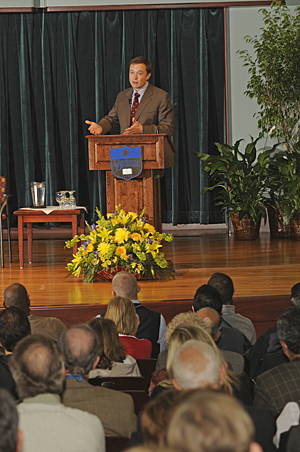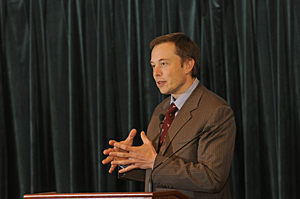

ADVERTISEMENT
- Rozovsky wins prestigious NSF Early Career Award
- UD students meet alumni, experience 'closing bell' at NYSE
- Newark Police seek assistance in identifying suspects in robbery
- Rivlin says bipartisan budget action, stronger budget rules key to reversing debt
- Stink bugs shouldn't pose problem until late summer
- Gao to honor Placido Domingo in Washington performance
- Adopt-A-Highway project keeps Lewes road clean
- WVUD's Radiothon fundraiser runs April 1-10
- W.D. Snodgrass Symposium to honor Pulitzer winner
- New guide helps cancer patients manage symptoms
- UD in the News, March 25, 2011
- For the Record, March 25, 2011
- Public opinion expert discusses world views of U.S. in Global Agenda series
- Congressional delegation, dean laud Center for Community Research and Service program
- Center for Political Communication sets symposium on politics, entertainment
- Students work to raise funds, awareness of domestic violence
- Equestrian team wins regional championship in Western riding
- Markell, Harker stress importance of agriculture to Delaware's economy
- Carol A. Ammon MBA Case Competition winners announced
- Prof presents blood-clotting studies at Gordon Research Conference
- Sexual Assault Awareness Month events, programs announced
- Stay connected with Sea Grant, CEOE e-newsletter
- A message to UD regarding the tragedy in Japan
- More News >>
- March 31-May 14: REP stages Neil Simon's 'The Good Doctor'
- April 2: Newark plans annual 'wine and dine'
- April 5: Expert perspective on U.S. health care
- April 5: Comedian Ace Guillen to visit Scrounge
- April 6, May 4: School of Nursing sponsors research lecture series
- April 6-May 4: Confucius Institute presents Chinese Film Series on Wednesdays
- April 6: IPCC's Pachauri to discuss sustainable development in DENIN Dialogue Series
- April 7: 'WVUDstock' radiothon concert announced
- April 8: English Language Institute presents 'Arts in Translation'
- April 9: Green and Healthy Living Expo planned at The Bob
- April 9: Center for Political Communication to host Onion editor
- April 10: Alumni Easter Egg-stravaganza planned
- April 11: CDS session to focus on visual assistive technologies
- April 12: T.J. Stiles to speak at UDLA annual dinner
- April 15, 16: Annual UD push lawnmower tune-up scheduled
- April 15, 16: Master Players series presents iMusic 4, China Magpie
- April 15, 16: Delaware Symphony, UD chorus to perform Mahler work
- April 18: Former NFL Coach Bill Cowher featured in UD Speaks
- April 21-24: Sesame Street Live brings Elmo and friends to The Bob
- April 30: Save the date for Ag Day 2011 at UD
- April 30: Symposium to consider 'Frontiers at the Chemistry-Biology Interface'
- April 30-May 1: Relay for Life set at Delaware Field House
- May 4: Delaware Membrane Protein Symposium announced
- May 5: Northwestern University's Leon Keer to deliver Kerr lecture
- May 7: Women's volleyball team to host second annual Spring Fling
- Through May 3: SPPA announces speakers for 10th annual lecture series
- Through May 4: Global Agenda sees U.S. through others' eyes; World Bank president to speak
- Through May 4: 'Research on Race, Ethnicity, Culture' topic of series
- Through May 9: Black American Studies announces lecture series
- Through May 11: 'Challenges in Jewish Culture' lecture series announced
- Through May 11: Area Studies research featured in speaker series
- Through June 5: 'Andy Warhol: Behind the Camera' on view in Old College Gallery
- Through July 15: 'Bodyscapes' on view at Mechanical Hall Gallery
- More What's Happening >>
- UD calendar >>
- Middle States evaluation team on campus April 5
- Phipps named HR Liaison of the Quarter
- Senior wins iPad for participating in assessment study
- April 19: Procurement Services schedules information sessions
- UD Bookstore announces spring break hours
- HealthyU Wellness Program encourages employees to 'Step into Spring'
- April 8-29: Faculty roundtable series considers student engagement
- GRE is changing; learn more at April 15 info session
- April 30: UD Evening with Blue Rocks set for employees
- Morris Library to be open 24/7 during final exams
- More Campus FYI >>
Editor's note: A podcast of the presentation by Elon Musk is available at the UD Podcasts Web site.
3:03 p.m., Nov. 6, 2009----From electric cars to exploring the stars, innovator and entrepreneur Elon Musk pursues his passion for progress with a wide-ranging vision that embraces both economic success and a sustainable energy future.
The South African-born chairman, CEO and product architect of Tesla Motors shared his vision during the second annual University of Delaware Presidential Lecture on Innovation and Entrepreneurship, held Thursday, Nov. 5, in the Roselle Center for the Arts.
UD President Patrick Harker welcomed Musk before a full-capacity audience in Gore Recital Hall.
“Lectures like these are part of an important tradition we're establishing here at UD, important for the University, for the community, for national prosperity and a better quality of life,” Harker said. “What we need is a network that encourages entrepreneurial thinking across the University and supports scholars, inventors, and innovators, all the way from the enterprise idea through its launch and well beyond.”
In mentioning Musk's many job titles, which also include CEO and chief technical officer of Space Exploration Technologies, or SpaceX, and chairman and principal shareholder of Solar City, the leading provider of solar power systems in California, Harker invited the audience to get a firsthand look at a pair of Tesla roadsters provided by their owners, Scott Johnson, co-founder and partner of Wilmington's Solar Dock, and John Reader, a 1983 UD electrical and computer engineering alumnus who is with TA Instruments.
“Outside on The Green are two Tesla Roadsters, one in blue and one in gold,” Harker said. “I swear that's a coincidence.”
Musk left his homeland at age 17, much against the wishes of his parents. He went on to earn a pair of undergraduate degrees in business and physics at the University of Pennsylvania, where he attended the Wharton School, of which Harker was dean before coming to UD.
“People ask me why I have done these things,” Musk said. “It's because I thought there were three areas that would most affect the future of the world: the transition to sustainable energy, the Internet and space exploration.”
The first of these areas of interest turned out to be the Internet, where Musk, with his brother Kimbal, started Zip2, which provided online content publishing software for news organizations. In 1999 the company was acquired by Compaq's AltaVista division for $307 million in cash and $34 million in stock options.
The next Internet business venture for Musk was forming X.com, an online financial services company that morphed into the PayPal electronic payment system.
“The initial idea was to put all the information in one place, to make it easier to transfer securities and cash from one customer to another by their e-mail addresses,” Musk said. “What people really responded to was e-mailing money. Folks really took to that.”
PayPal, which was sold to eBay for $1.5 billion in 2002, now has 200 million customers in 190 countries, Musk said.
“That gave me the capital to work on some of the other areas that I thought would really make a difference,” Musk said. “Since I already had two Internet companies, I wanted to work on sustainable energy and space exploration.”
Musk noted that his next venture, SpaceX, which develops and manufactures space launch vehicles, was definitely his most challenging technical venture to date.
“We developed everything, from the main engine and the upstage engine and the control systems to the launch pad,” Musk noted. “The reason it is so hard is that you can't replicate the conditions the rockets will encounter in space.”
“It is like having a really difficult software program that you can't test on the computer that it is supposed to run on, but that you are supposed to put on a computer and have it run without a single bug,” Musk said. “Rockets are hard. There is a reason why you have those idiomatic expressions about why we can't all be rocket scientists.”
While a series of problems plagued the first three launches, the next attempt was a success, proving, Musk noted, “that the fourth time is a charm.”
Having successfully conducted two static firings of the first stage nine-engine cluster for its Falcon 9 launch vehicle at the company's 300-acre structural and propulsion testing facility just outside of Waco, Texas, the next step will be the preparation of its first flight from Cape Canaveral, Fla., slated for sometime next year, Musk said.
“This was a pretty tough competition, and on Sept. 23, NASA called and said that we had won a contract for 12 of the next 20 missions,” Musk said. “This represents six and a half years of company time. We do the final checkout this month in Cape Canaveral, and hopefully will launch around March 2010. The third flight will probably go to the International Space Station.”
SpaceX will start out with cargo launches before eventually carrying a crew that will dock at the International Space Station, Musk said. For more information on SpaceX, including the company's Falcon 1, Falcon 9 and Dragon spacecraft, as well as a launch video shown by Musk during his talk at UD, visit the Web site.
Having tackled the Internet and outer space, Musk turned his entrepreneurial expertise toward the third of his goals, working towards a sustainable energy future.
As principal owner and CEO of Tesla Motors, Musk is involved in the production of the all-electric sports car line that features the Telsa Roadster and the Tesla S, which is slated for production by 2011. The company is named for Nikola Tesla (1886-1943), an inventor and electrical engineer and scientist.
With zero-to-60 acceleration of 3.9 seconds and a top speed of 125 miles per hour, the Tesla Roadster has a driving range of 244 miles and can be completely recharged in 3.5 hours. For more information about Tesla Motors, visit the Web site.
While the starting price of the Tesla Roadster is $109,000, the company plans to offer the four-door Tesla S for a starting price of $49,000, Musk said.
“Even though the space thing was more than enough to keep me busy, I felt there really was a need for this electric car,” Musk said. “Developing the Tesla is a catalyst to the idea of transferring to a sustainable energy future. I felt it was something that had to be done.”
In 2007, Musk was recognized for his work as the recipient of Research and Development Magazine's Innovator of the Year Award, as well as by Inc. Magazine as its entrepreneur of the year. He also received the 2007-08 American Institute of Aeronautics and Astronautics award for the greatest contribution to the field of space transportation.
When asked during a question and answer session how he manages to wear two hats of CEO and leader as well as innovator and generator of ideas, Musk said that most ventures involve “1 percent inspiration and 99 percent perspiration.”
“With PayPal we were able to make the best product,” Musk said. “Once you get the idea, it's really all about the execution.”
Article by Jerry Rhodes
Photos by Duane Perry


